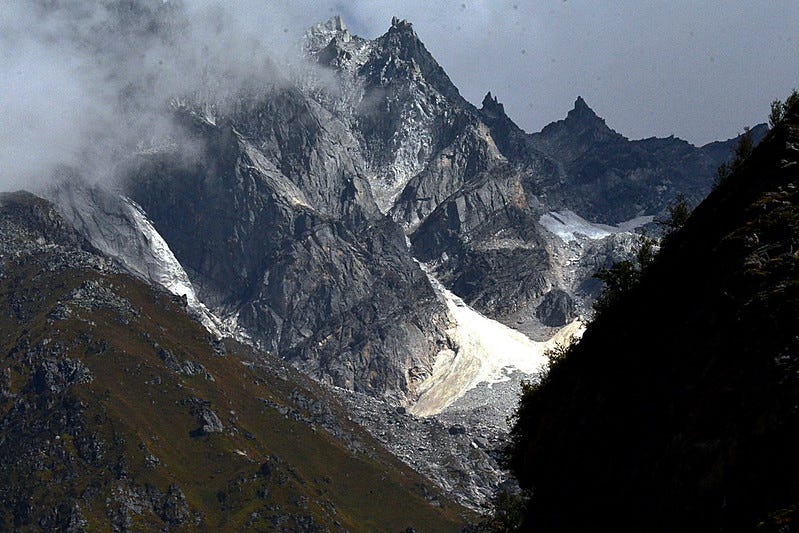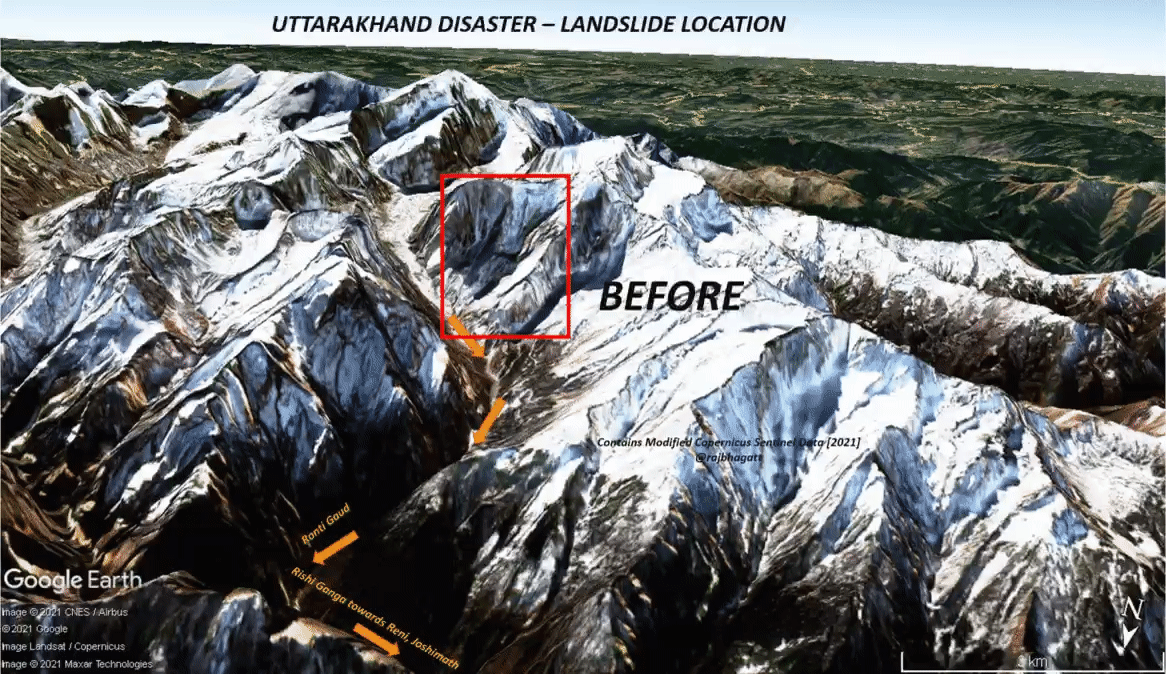The Weekend Read: The Himalayas' new normal under climate change
In conversation with IPCC author Anjal Prakash
Welcome to this weekend’s edition of Lights On, a newsletter that brings you the key stories and exclusive intel on energy and climate change in South Asia.
Today’s interview puts into context one of the most dramatic environmental tragedies to hit the Himalayan region, last week’s avalanche in northern India. In case you missed it, catch up with this week’s explainer of the landmark India’s Energy Outlook report.
If you are not a subscriber, you can sign up below, for free, or you can support my work by purchasing a membership:

A huge flood swept through the Chamoli district in the Northern State of Uttarakhand on February 7, leaving 38 dead and 168 missing. Scientists are now trying to establish if such a destructive event could have been anticipated, whether climate change is to blame and how to prepare in case it happens again. While the jury is still out on the exact nature and causes of the flood, experts agree that climate change is affecting the Himalayas in ways that we are yet to map out. I looked for answers with Anjal Prakash, research director with the Indian School of Business in Hyderabad. He was lead author of the Intergovernmental Panel on Climate Change (IPCC) special report on Oceans and Cryosphere in 2018, and is lead author of the ongoing 6th Assessment report due to be finalised this year.
Lights On: What do we know so far about the flood in Uttarakhand? Scientists are exploring the possibility of it being linked to climate change.
Anjal Prakash: Scientists are still not clear on what exactly has happened. Designated agencies have already sent teams on the ground to inspect the area. They have already looked at the available satellite imagery, but teams have gone to physically verify what exactly has happened. Until we get a report from them it’s all speculation, but one thing is very clear: global warming is one of the main reasons why these glaciers are melting, and whatever happened could be attributed to global warming. The days prior to the event saw some heavy snowfall, which is normal in this season, followed by a few abnormally sunny days, which was unexpected. And this is what climate change does, it surprises you, it disturbs weather patterns making them very unpredictable.


Let’s introduce the Himalayas to our readers abroad who may not be familiar with the region. Why is this area important globally, and why is it particularly vulnerable?
The Himalayan region is known as the Third Pole, it is the largest concentration of freshwater ice apart from the two poles. The entire Hindu Kush Himalayan region consists of eight countries starting from Afghanistan, all the way down to Myanmar and including India and China, and it’s one of the newest mountain ranges in the world. Compared with other mountains of similar nature, it’s thickly populated, which means that humans interact more with the local environment.
Due to climate change, glaciers here are melting at a much faster rate. Numerous IPCC reports have been pointing out that environmental changes in the region are abnormally drastic, their magnitude and frequency is going to be increasing in the future. It's a high climate risk zone, and glacier melt can lead to sudden landslides and glacial bursts like what happened in Uttarakhand.
So how do changing weather patterns lead to extreme events such as last week’s?
I work on the social science aspect of climate change, and a glaciologist may be able to give you more detailed information, but generally, as snow deposits on the glaciers, they become bigger. This takes time, and temperatures low enough for the snow to become compact, freeze and eventually become part of the ice cap. So this can happen only through a prolonged, dry cold spell. But say you have a sudden bout of rain, or there is a very sunny day, the fresh snow will just melt.
What happened in Uttarakhand is a phenomenon known as glacial lake outburst flood, or GLOF. When a glacier melts, if there is space underneath the water accumulates and creates a lake. If you suddenly end up with a huge amount of water impounded in a relatively small reservoir, it can break out and flood the river. And again, because weather patterns are changing very fast, this can happen suddenly.
Is there any way in which humans could potentially reduce this risk?
We were poorly prepared because we have not been monitoring these areas. In the entire Hindu Kush Himalayan region, we have about 54,000 odd glaciers, and in Uttarakhand itself there are 1,500 glaciers. Out of those only 12 to 15 big glaciers are being monitored. Due to lack of resources, there are not many physical stations out there, nor satellite imagery or other monitoring mechanisms, that's why now there's so much confusion over what has happened. Had we been monitoring these glaciers, we would have known much earlier exactly what was happening.
Given the region’s unique vulnerabilities, including dense population and accelerated climate change, can you share your thoughts on how Himalayan communities could and should prepare for similar events in future?
I think very rarely people ask me this question. The climate change process is ongoing, and it’s not going to stop even if humans stopped all emissions today - even then, it would take three decades to fix the problem. So climate change is going to be staying, along with the increased chance of this kind of phenomena. The only thing we can do now is to focus on minimising their impacts, on adaptation.
For example, knowing that heightened climate risk will be the new normal, we’ll have to be very careful what we are doing in the Himalayas to disturb the local ecology. So, in this case, for example, the local hydropower plant still under construction [the Tapovan Vishnugad power plant] has been completely washed away, together with the financial investment it required, with just one flood. That goes to show how careful we need to be with what we plan in those areas.
How does this ‘new normal’ influence the lives of the mountain communities?
This is a thickly populated area, and the local communities are among the poorest, often lacking access to land or basic services such as roads, water, sanitation, health and education. And you can't move them out from those places because they have been living there for generations. That means you also need to bring in access to at least the basic services to these areas.
You need to work on environmentally benign projects. For example, if you want to work to provide electricity to those remote areas, micro hydro is a much better option than the run-of the-river, large scale hydropower. Micro hydro can provide electricity to a small hamlet and if connected [to other stations] it can also generate energy at a large scale, but that requires an understanding of decentralised planning. Similarly for roads, you need to build roads because some of the areas are highly inaccessible. These things are a human rights issue, they need to be there, but you have to take the local ecology into account when building them.
Can you give me an idea of what ecologically sensitive planning would look like in the Himalayas?
Imagine you have a large scale program to restore all the forest bodies of the Himalayas, and you use the money that you were going to put into hydropower, that will give you a co-benefit, because trees are the first line of defense when an avalanche happens. And as much as tree cover helps you cope with some of these issues, it also gives you a mitigation benefit, because it sucks carbon dioxide. And if you are concerned about profit, some of these forest areas will also give returns in terms of forest based economy: for example, Himalayan honey will be one of the best of the world, if you are able to fix the environment and grant rights to the local people, they can produce goods which can be exported. It just requires a change of thinking.
That’s all for today! If you like what you read, please consider signing up for free or as a member:




Great piece today, Lou.